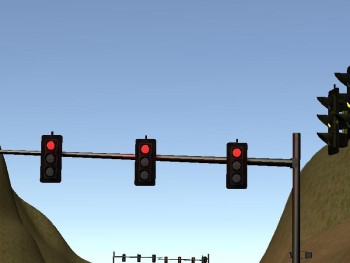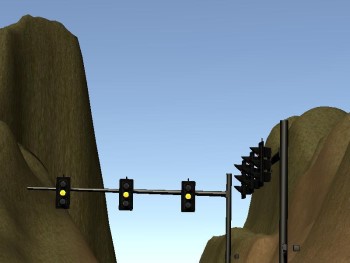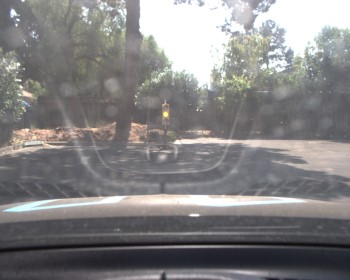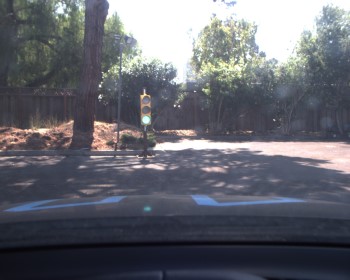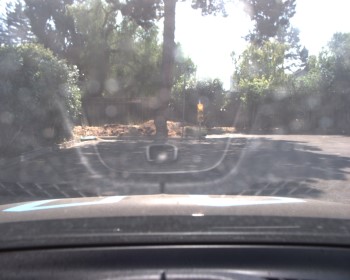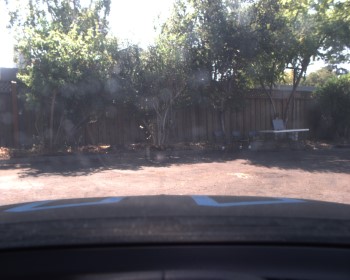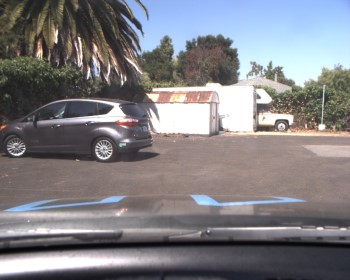The repository contains the instructions and links to the datasets for the pipeline used in training an object detector for traffic lights to be integrated into the final Capstone project of the Udacity Self Driving Car Nanodegree.
The project requires to detect traffic lights from the image send by the onboard camera and classify the detections into the 3 available categories: green, yellow and red so that the car can decide on how to behave in proximity of traffic lights.
One of the possible approaches would be to first run an object detector and then run a classifier, while a good solution this would require to train 2 different models and run them both in sequence. This may add overhead as the performance penalty to run the separate classifier, even though small might affect the driving behaviour.
The approach we took is instead to train an end-to-end model on an object detection pipeline, treating each traffic light state as a separate class, this approach comes from the the work done by Bosch on their Small Traffic Light Dataset.
We use the TensorFlow Object Detection API in order to fine-tune the available models already trained on the COCO Dataset.
TLDR; The final datasets used for training can be downloaded from here.
For this task we decided to perform transfer learning on some well known models using a relatively small dataset of mixed manually annotated and semi-automatically annotated images that were collected from the both the Udacity Simulator and the ros bags provided for training.
The dataset is composed of images coming from 4 source:
-
The udacity simulator
-
A training bag file with a video of traffic lights provided by Udacity as training (Download)
-
A traffic lights bag file with a video of traffic lights only, recorded on the Carla testing site (Download)
-
A loop bag file with a video of a complete loop, recorded on the Carla testing site (Download (Same as above))
-
An additional test run bag file with a video of a complete loop, recorded at the test site on a very sunny day with a lot of flare.
The images manually annotated were labelled with LabelImg while for the semi-automatic annotation a small utility is included that runs one of the tensorflow pretrained models on a set of images capturing the bounding boxes and labelling them with a predefined label:
$ python label_data.py --data_dir=data/simulator/red --label=red --model_path=models/ssd_inception_v2_coco_2018_01_28/frozen_inference_graph.pbNote that all the annotations in the dataset were manually verified and/or adjusted.
In order to train the model using the object detection API the images needs to be fed as a TensorFlow Record, the repository contains a small utility (loosely based on the TensorFlow object detection api tool) that converts the annotated images into a TensorFlow Record optionally splitting the dataset into train and validation:
$ python create_tf_record.py --data_dir=data/simulator --labels_dir=data/simulator/labels --labels_map_path=config/labels_map.pbtxt --output_path=data/simulator/simulator.recordFor more details about the conversion to TF Records see https://github.com/tensorflow/models/blob/master/research/object_detection/g3doc/using_your_own_dataset.md.
The final annotated dataset can be downloaded from here, it contains both the images and annotation and the final tensorflow record used for training and evaluation:
carla
L carla_eval.record
L carla_train.record
L carla.zip
simulator
L simulator_eval.record
L simulator_train.record
L simulator.zip
extra
L extra.zip
mixed_eval.record
mixed_train.record
extra_mixed_eval.record
extra_mixed_train.record
The mixed_eval.record and mixed_train.record are the record files used for training the models; they contain images from the simulator, from the training bag provided by udacity and from the traffic lights bag on Carla site, they do not contain any image extracted from the loop bag recorded on the carla site as it is used for testing the models later on.
The carla.zip contains images for training and testing, the latter contains the images from the loop bag on the Carla site, while the former contains a mix of images from the training bad and the traffic lights bag.
The extra.zip archive contains additional images taken from a run on the Carla test lot on a bright sunny day with a lot of flares, the extra_mixed_eval.record and extra_mixed_train.record files are the record files that contains the samples including the this additional images.
In the following the statistics of the dataset used (does not include images without traffic lights):
| Dataset | Samples | Training | Evaluation |
|---|---|---|---|
| Simulator | 422 | 316 | 106 |
| Carla Training | 1411 | 1058 | 353 |
| Carla Testing | 254 | N/A | N/A |
| Carla Extra | 304 | N/A | N/A |
| Sim + Carla | 1833 | 1374 | 459 |
| Sim + Carla + Extra | 2137 | 1709 | 428 |
In order to train the model we use the TensorFlow Object Detection API, which is not fully released and stable yet but it's usable with some workarounds.
The models that we took into consideration come from the model zoo provided by tensorflow, in particular we chose models that are pre-trained on the COCO Dataset since it contains the traffic light category which is useful for us in order to fine-tune the models, considering only those models that reports a balance between speed and accuracy:
| Model name | Reported Speed (ms) | Reported COCO mAP[^1] | Template Config | Repo Config |
|---|---|---|---|---|
| ssd_mobilenet_v1_coco | 30 | 21 | Download | Download |
| ssd_mobilenet_v2_coco | 31 | 22 | Download | Download |
| ssd_inception_v2_coco | 42 | 24 | Download | Download |
| ssdlite_mobilenet_v2_coco | 27 | 22 | Download | Download |
| faster_rcnn_inception_v2_coco | 58 | 28 | Download | Download |
The repository contains various configuration files for the different datasets (mixed is the simulator + carla dataset) for different models, the things that I changed from the samples provided by tensorflow are:
- The various training and validation paths of the tf records (e.g. input_path elements)
- The label_map_path
- The num_classes
- The num_steps
- The num_examples in the evaluation section that correspond to the number of samples in the evaluation record
- The ssd_anchor_generator section, updating the scales and removing unused aspect ratios (the traffic lights are more or less 0.33)
- Reduced the number of detections from 100 to 10 in max_detections_per_class and max_total_detections
For example (taken from the ssd_inception_v2 config):
model {
ssd {
num_classes: 3
...
anchor_generator {
ssd_anchor_generator {
num_layers: 6
min_scale: 0.1
max_scale: 0.5
aspect_ratios: 0.3333
reduce_boxes_in_lowest_layer: true
}
}
...
}
}
...
train_config: {
...
fine_tune_checkpoint: "models/ssd_inception_v2_coco_2018_01_28/model.ckpt"
from_detection_checkpoint: true
num_steps: 20000
...
}
train_input_reader: {
tf_record_input_reader {
input_path: "data/mixed_train.record"
}
label_map_path: "config/labels_map.pbtxt"
}
eval_config: {
num_examples: 459
# Note: The below line limits the evaluation process to 10 evaluations.
# Remove the below line to evaluate indefinitely.
max_evals: 10
}
eval_input_reader: {
tf_record_input_reader {
input_path: "data/mixed_eval.record"
}
label_map_path: "config/labels_map.pbtxt"
shuffle: false
num_readers: 1
}
All the models were trained on AWS instances with the following common configuration:
| Batch Size | Steps | Learning Rate | Anchors Min Scale | Anchors Max Scale | Anchors Aspect Ratio |
|---|---|---|---|---|---|
| 24 | 20000 | 0.004 | 0.1 | 0.5 | 0.33 |
The models can be trained locally following the steps below (assuming tensorflow is installed already):
-
Download the trained models from the TensorFlow Model Zoo with their associated pipeline configuration.
-
Download the TensorFlow Object Detection API and perform the required installation steps:
-
Clone the tensorflow object models repo:
git clone https://github.com/tensorflow/models.git temp
-
Copy temp/research/object_detection and temp/research/slim
xcopy /E temp/research/object_detection object_detection xcopy /E temp/research/slim slim
or (on linux)
cp -r temp/research/object_detection object_detection cp -r temp/research/slim slim
-
Install dependencies:
conda install Cython contextlib2 pillow lxml matplotlib
-
Install the COCO Api:
```sh pip install git+https://github.com/philferriere/cocoapi.git#egg=pycocotools^&subdirectory=PythonAPI ``` or (under linux) ```sh git clone https://github.com/cocodataset/cocoapi.git cd cocoapi/PythonAPI make cp -r pycocotools ../../ ``` -
Download protoc 3.4.0 and extract the protoc executable:
https://github.com/protocolbuffers/protobuf/releases/download/v3.4.0 -
Compile proto buffers:
protoc object_detection/protos/*.proto --python_out=. -
Set PYTHONPATH:
SET PYTHONPATH=%cd%;%cd%\slim
or (on linux)
export PYTHONPATH=$PYTHONPATH:`pwd`:`pwd`/slim
-
Run tests:
python object_detection/builders/model_builder_test.py
If you run into "TypeError: can't pickle dict_values objects" look into object_detection/model_lib.py for
category_index.values()and replace withlist(category_index.values())
-
-
Configure the pipeline, copies of the configurations used can be found in the config folder.
-
Run the training session:
python object_detection/model_main.py --pipeline_config_path=path/to/the/model/config --model_dir=path/to/the/output -
Watch it happen with tensorboard:
tensorboard --logdir=path/to/the/outputAnd open the browser to
https://{machine_ip}:6006
To train on AWS I used the Amazon Deep Learning AMI (v20 with tensorflow 1.12) and GPU graphics g3s.xlarge instance type (it has a more recent GPU and costs less than other GPU instances even though less ram), alternatively the GPU Compute p2.xlarge works fine (it's a tiny bit more expensive). I used spot instances with 5-6 hours request length (making sure to uncheck the delete volume option).
Once the instance is up and running we need to prepare the environment:
-
Connect to the instance:
$ ssh ubuntu@instance-public-dns
-
Activate the tensorflow environment:
$ source activate tensorflow_p36 -
Install the object detection API (E.g. From the linux installation steps):
- Get the object detection API:
git clone https://github.com/tensorflow/models.git tmp cp -r tmp/research/object_detection object_detection/ cp -r tmp/research/slim slim/
- Install dependencies:
sudo apt-get install protobuf-compiler python-pil python-lxml python-tk pip install Cython contextlib2 matplotlib
- Install the coco API:
git clone https://github.com/cocodataset/cocoapi.git cd cocoapi/PythonAPI make cp -r pycocotools ../../pycocotools - Compile the proto buffers:
protoc object_detection/protos/*.proto --python_out=. - Add the library to PYTHONPATH (Note: this expires with the session, put it in a script):
export PYTHONPATH=$PYTHONPATH:`pwd`:`pwd`/slim
- Test the installation:
python object_detection/builders/model_builder_test.py
- Get the object detection API:
-
Download a model, for example SSD with Inception:
mkdir models cd models wget https://download.tensorflow.org/models/object_detection/ssd_inception_v2_coco_2018_01_28.tar.gz tar -xzvf ssd_inception_v2_coco_2018_01_28.tar.gz cd ..
-
Download the dataset from https://drive.google.com/open?id=1NXqHTnjVC1tPjAB5DajGc30uWk5VPy7C and upload the record files to the
datafolder -
Run the training:
python object_detection/model_main.py --pipeline_config_path=config/ssd_inception_v2.config --model_dir=models/fine_tuned/ssd_inception
If you want to run in it background:
nohup python -u object_detection/model_main.py --pipeline_config_path=config/ssd_inception_v2.config --model_dir=models/fine_tuned/ssd_inception > training.log & -
Run tensorboard:
tensorboard --logdir=models/fine_tuned
or in background:
nohup tensorboard --logdir=models/fine_tuned > tensorboard.log &
NOTE: If you want to see some logging in the std out just add tf.logging.set_verbosity(tf.logging.INFO) after the imports in ./object_detection/model_main.py
If your spot instance is stopped while training and you made sure to uncheck the "delete volume" option when requesting the spot instance, your volume will be retained and you can continue the training from a previous checkpoint:
-
Request a new instance
-
Go to the volumes and attach the previous volume to the new instance
-
Connect to the instance and mount the previous volume:
mkdir /prev_volume sudo mount /dev/xvdf1 /prev_volume
Note that the device name
xvdf1can be found runninglsblk. -
Copy the old model to the new instance
cp -r /prev_volume/home/ubuntu/models/fine_tuned /models/fine_tuned
-
Run the training with the same configuration (it will pick up the last checkpoint)
python object_detection/model_main.py --pipeline_config_path=config/ssd_inception_v2.config --model_dir=models/fine_tuned/ssd_inception
Google provides the Colab space to run interactive jupyter notebooks with GPU enabled VMs, it's an handy environment for experimenting, the repository contains a custom jupyter notebook that can be used to train the models using the tensorflow object detection API directly on Google Colab: colab_training.ipynb.
Simply import the notebook in your colab space, activate the GPU (under file->settings) and change the train_file_id and eval_file_id to match the id of the mixed_train.record and mixed_eval.record in your google drive so that they can be downloaded in the colab workspace. In order to get the id of the files in google drive simply obtain a sharable link and copy the id from the link.
In order to use the model for inference in production the graph must be freezed, the tensorflow object API comes with an handy utility to export the frozen model (See https://github.com/tensorflow/models/blob/master/research/object_detection/g3doc/exporting_models.md):
python object_detection/export_inference_graph.py --input_type=image_tensor --pipeline_config_path=config/ssd_inception_v2.config --trained_checkpoint_prefix=models/fine_tuned/ssd_inception_v2/model.ckpt-20000 --output_directory=models/exported/ssd_inception_v2This will create a frozen_inference_graph.pb graph that can be loaded from tensorflow:
import tensorflow as tf
import os
file_path = os.path.join('models', 'fine_tuned', 'ssd_inception', 'frozen_inference_graph.pb')
detection_graph = tf.Graph()
with detection_graph.as_default():
od_graph_def = tf.GraphDef()
with tf.gfile.GFile(file_path, 'rb') as fid:
serialized_graph = fid.read()
od_graph_def.ParseFromString(serialized_graph)
tf.import_graph_def(od_graph_def, name='')And later used in a session as follow:
with detection_graph.as_default():
image_tensor = graph.get_tensor_by_name('image_tensor:0')
boxes_tensor = graph.get_tensor_by_name('detection_boxes:0')
scores_tensor = graph.get_tensor_by_name('detection_scores:0')
classes_tensor = graph.get_tensor_by_name('detection_classes:0')
detections_tensor = graph.get_tensor_by_name('num_detections:0')
ops = [detections_tensor, boxes_tensor, scores_tensor, classes_tensor]
with tf.Session() as sess:
num_detections, boxes, scores, classes = sess.run(ops, feed_dict={image_tensor: image})The models were trained using the latest version of tensorflow (1.12 at the time of writing) and object detection api, the software stack included on Carla self-driving car include instead tensorflow 1.3. Despite what google claims the models are not always compatible within major versions so we have to convert the frozen model using an older version of the object detection api and tensorflow. Unfortunately the object detection API only goes back to tensorflow 1.4 (the previous version is in one of the commits in the original tensorflow repository) luckily it appears that models converted with this version are also compatible with tensorflow 1.3.
Note that once the model is converted it is possible to load it from tensorflow version >= 1.3.
To convert the model we use the following procedure (using conda and tensorflow without GPU) which is the same as exporting a model, just using a different version of tensorflow and the object detection API:
-
Create conda env for tensorflow 1.4:
conda create -n tensorflow_1.4 python=3.6 conda activate tensorflow_1.4
-
Install tensorflow 1.4.0:
conda install tensorflow==1.4.0
-
Install dependencies:
conda install pillow lxml matplotlib
-
Clone the tensorflow object models repo and checkout compatible version:
git clone https://github.com/tensorflow/models.git temp cd temp git checkout d135ed9c04bc9c60ea58f493559e60bc7673beb7 -
Copy temp/research/object_detection and temp/research/slim to the exporter
mkdir exporter xcopy /E temp/research/object_detection exporter/object_detection xcopy /E temp/research/slim exporter/slim cd exporteror (on linux)
mkdir exporter cp -r temp/research/object_detection exporter/object_detection cp -r temp/research/slim exporter/slim cd exporter -
Download protoc 3.4.0 and extract the protoc.exe into /exporter:
https://github.com/protocolbuffers/protobuf/releases/download/v3.4.0
-
Compile proto buffers:
protoc.exe object_detection/protos/*.proto --python_out=. -
Set PYTHONPATH:
SET PYTHONPATH=%cd%;%cd%\slim
or (on linux)
export PYTHONPATH=$PYTHONPATH:`pwd`:`pwd`/slim
-
Run tests:
python object_detection/builders/model_builder_test.py
-
Export the model(s) as before:
python object_detection/export_inference_graph.py --input_type=image_tensor --pipeline_config_path=../config/ssd_inception_v2.config --trained_checkpoint_prefix=../models/fine_tuned/ssd_inception_v2/model.ckpt-20000 --output_directory=../models/converted/ssd_inception_v2
Once the model is frozen, its variables are turned into constants. Additionally we can perform various optimizations to increase the inference throughput, for example removing unused variables or folding operations (See the documentation for the graph transforms for more details).
The repository includes a small utility that allows to run such optimizations, note that we can run the optimizations on both the exported frozen graph or on the converted one for tensorflow 1.3, just making sure to use the correct version of tensorflow when doing so:
$ python optimize_graph.py --model_path=models/converted/ssd_mobilenet_v2/frozen_inference_graph.pb --output_dir=models/optimized/ssd_mobilenet_v2For example for ssd_mobilenet_v2, optimizing the converted graph using tensorflow 1.4 yields interesting resutls:
| Constant Count | Identity Count | Total Nodes | |
|---|---|---|---|
| Before | 1116 | 468 | 2745 |
| After | 487 | 4 | 1150 |
The repository contains the various models under the saved_models folder:
saved_models
L exported # The fine tuned models (checkpoint + frozen graph)
L exported_optimized # The optimized models (frozen graph)
L converted # Exported models converted for tf 1.3 (frozen graph)
L converted_optimized # The optimized version of the converted models (frozen graph)
All the models were trained with a similar configuration and the following common parameters:
| Batch Size | Steps | Learning Rate | Anchors Min Scale | Anchors Max Scale | Anchors Aspect Ratio |
|---|---|---|---|---|---|
| 24 | 20000 | 0.004 | 0.1 | 0.5 | 0.33 |
For the evaluation of the model we are interested in the classification of the images rather than the IOU of the predicted box, a jupyter notebook is included that simply runs the trained models on the set of images and computes the accuracy (in terms of correctly classified samples/total samples). The evaluation includes also "background" images that do not contain any traffic light to test for false positives. The following system configuration was used for the evaluation:
| CPU | GPU | RAM |
|---|---|---|
| Intel I7 8650U ([email protected], [email protected]) | Nvidia GTX 1050 2GB ([email protected], [email protected]) | 16GB |
The accuracy is measured on both images from the simulator and images from the Carla test site, we additionally report the GPU and CPU time for both the exported (frozen) graphs and the optimized version:
| Model | Acc (Sim) | Acc (Site) | GPU Time (ms) | Optimized | CPU Time (ms) | Optimized |
|---|---|---|---|---|---|---|
| ssd_mobilenet_v1 | 0.958 | 0.868 | 21.6 | 19.4 | 66 | 60.8 |
| ssd_mobilenet_v2 | 0.970 | 0.938 | 21.6 | 19.5 | 67 | 56.4 |
| ssdlite_mobilenet_v2 | 0.996 | 0.860 | 25.4 | 23.1 | 74 | 57 |
| ssd_inception_v2 | 0.996 | 0.888 | 34.6 | 29.7 | 130 | 135.4 |
| ssd_inception_v2_sim* | 0.996 | 0.303 | 34.1 | N/A | 139 | N/A |
| extra_ssd_mobilenet_v2** | 0.996 | 0.946 | 21.6 | 19.5 | 67 | 56.4 |
| extra_faster_rcnn_inception_v2** | 0.982 | 0.970 | 91.8 | 86.3 | 1028.4 | 1032 |
* Trained on simulator images only ** Trained with the extra images dataset
Note that we also performed a test training ssd with the inception feature extractor only on simulator images, as expected the model does not generalize much and fails on the images coming from the carla test site.
The ssd_mobilenet_v2 improves a lot in accuracy in respect to the previous version of the feature extractor (mobilenet_v1) retaining the same performance. The model can run in real time, consuming in average 21.6 ms of GPU time (~46 FPS) with the optimized model improving a little with 19.5 ms (~51.2 FPS). Interestingly the model is capable of generalizing better than ssd_inception_v2 despite the smaller network.
An addiotonal pass was done integrating a few additional images from an extra run on the testing lot of Carla that produced very bright and flared images, training the model using the this dataset increased the accuracy of ssd_mobilenet_v2 on both the simulator and the real images.
The extra_faster_rcnn_inception_v2 model reaches the best accuracy on the test (unseen) set but takes a toll on the system obtaining relatively poor performance in terms of inference speed (86.3 ms, ~11.6 FPS).


